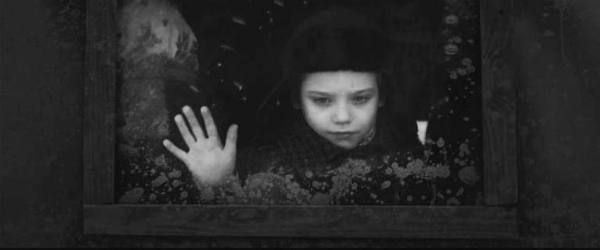‘House with a Turret’ Goes Beyond Mere Decoration

By Jim Lichacz / LA Film Fest Guest Blogger
The art of cinema is alive and well at the Los Angeles Film Festival; I’ve seen it with my own eyes. House with a Turret speaks through image and sound, creating a stirring cinematic experience. Together, the director and cinematographer effortlessly weave a suffused palette of human dignity and determination across the screen.
The second feature film from Ukrainian director Eva Neymann, House was shot on 35mm black and white film that captures the very essence and soul of whatever comes across cinematographer Rimvydas Leipus’ camera lens. Of course, it takes more than a good cinematographer and black and white film to create art. The director needs a good story to tell that is rich with symbolism, a cast that imparts heartfelt meaning and an audio track that amplifies the subtext.
House with a Turret has them all.
The story centers on a young boy forced to navigate through the Soviet Union toward the end of WWII. He is very capable and has no problem finding safety in a world of adults working to survive while retaining their dignity. His landscape is one of distressed elegance, populated with characters moving forward as if in a trance, but still maintaining their inner resilience. The camera pans across and through them, where they burn their essence onto the film. You cannot turn your eyes from the screen as each expression, nuanced posture or texture of clothing conveys an aspect of their inner self. It’s mesmerizing to watch.
Imagine taking a character that has the intensity and compassion of the boy from The Tin Drum, adding a touch of the charm from a film like Moonrise Kingdom, then visually referencing the look of a Fellini film—where the characters and decaying setting create a rich visual panorama. At least, those were the references I used to help make sense of how this film could have gestated. Neymann started her film career as a documentary filmmaker, and she also makes good use of that experience here.
Furthering the artistic aspect of the film, there is a good deal of symbolism the viewer is left to interpret. Not having read much Russian literature or many Marxist political tracts, my desire to decode the film was heightened. House with a Turret is not one of those films that have a nicely wrapped ending; instead, you are presented with a series of images that require you to impart your own meaning. But it’s not some wacky ethereal ending either—it has substance and depth.
The film has done very well on the international film circuit and I have to imagine it jumped onto the Festival programming radar early on. However it came to be, I thank the forces of cinematic art the film gets to be shown in Los Angeles and there is an eager audience for it.
House with a Turret screens at the LA Film Fest for the last time today, June 23 at 2:40pm. More information available here »
